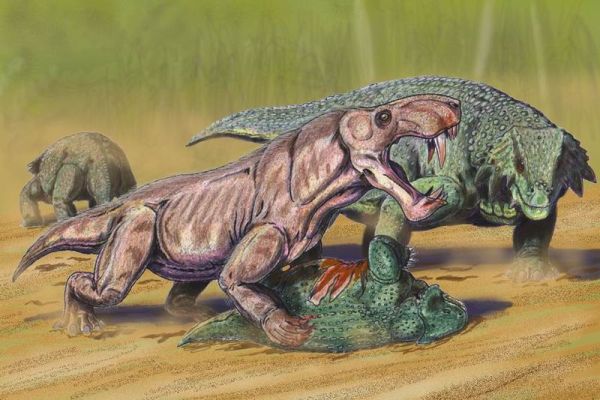| Lopingian epoch | ||
| Permian Period | Lopingian |
| Capitanian | Guadalupian | Carboniferous | Permian | |
| Wuchiapingian | Early Triassic | Triassic | Wuchiapingian | Timescale |

A juvenile Scutosaurus pareiasaur falls victim to the gorgonopsid superpreditor Inostrancevia . An adult Scutosaur wartches helplessly nearby.
Late Wuchiapingian to Changhsingian age - Urals region of Russia (Low latitude northern Pangea)
image by Dmitry Bogdanov - Wikipedia
The Lopingian stage constitutes the later subdivision of the Late Permian, which follows immediately from the Guadalupian. It is divided into two unequal epochs, the long Wuchiapingian and the short (only about 2 million years) Changhsingian. The Lopingian, Wuchiapingian and Changhsingian stages are named after Chinese localities where fossils and rock strata of this age occur in a good and mostly unbroken series. As part of the current revision of Permian stratigraphy, "Lopingian" and "Guadalupian" have replaced earlier terms like "Upper Permian", "Zechstein", "Tartarian", and "Dzulfinan" in international usage (although the latter three terms are still applied locally).
The Lopingian sub-period lasted almost as long as the preceding Guadalupian, approximately 9 million years. This was a period of great stress for eco-systems, as the climate continued to dry and the single large continent of Pangea did not provide much room for diversity (the more isolated islands and continents, the more species). Throughout the Permian period the numbers of invertebrate species tends to decrease. At the end of the Lopingian there is a period of enormous vulcanism (in what is now Siberia), which further stresses ecosystems by introducing acid rain into the atmosphere. Finally, at the end of the period there appears to have been either a tremendous period of vulcanism or an extraterrestrial impact (possibly a comet or giant asteroid similar to the one that killed the dinosaurs), as 95% of species of living beings suddenly die out within a very short period. The Paleozoic era comes to an end and new species inherit the globe.
In the dry late Permian environment many types of synapsids and reptiles flourished. The giant dinocephalians of the Middle Permian had vanished, but the big pareiasaurs were still around, sharing the world with various types of more advanced therapists that had likewise survived, including the large gorgonopsians like Inostrancevia, shown above, the small to medium-sized therocephalians, the newly evolved and very mammal-like condones like Procynosuchus, and an astonishing diversity of herbivorous dicynodonts The large Aulacephalodon is shown here, but other types were small and rodent-like). A great small many insectivorous lizard-like diapsid reptiles, like Paliguana, inhabited the landscape, most of which, curiously, had hind-legs much longer than their forelimbs (clearly an adaptation to bipedal locomotion, like the frill-necked lizard of Australia today). Finally, amphibians, although reduced in numbers, were nevertheless present and included animals of large size. The aquatic rhinesuchid temnospondyls were clearly the successors of the Middle Permian melosaurs and early Permian eryopids, both of which they resembled closely in size, appearance, and no doubt habits as well.
As the biggest animals around, the fearsome looking, but herbivorous, pareiasaurs were nevertheless not free of danger. They had outlasted the carnivorous anteosaurian dinocephalians, but now the previously small and insignificant gorgonopsians had evolved to large forms up to the size of a modern lion or bear) to take their place. These animals, the equivalent of the sabre-toothed cat of the Cenozoic era, used their enormous canines to bring down the ox-sized pareiasaurs. Gorgonopsians and pareiasaurs may even have formed a "co-adaptive pair"; (like the Smilodon- mammoth 'relationship' of the Pleistocene) the gorgonopsians evolved in larger, more robust and larger fanged forms (for example Dinogorgon and Inostrancevia) whereas their pareiasaur prey become more armoured (for example Pareiasaurus and Scutosaurus). Both groups became simultaneously extinct and the end of the Permian.